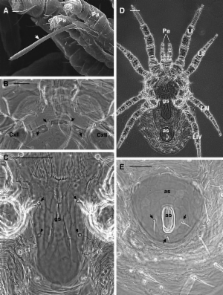- Record: found
- Abstract: found
- Article: found
A gallery of the key characters to ease identification of Dermanyssus gallinae (Acari: Gamasida: Dermanyssidae) and allow differentiation from Ornithonyssus sylviarum (Acari: Gamasida: Macronyssidae)

Read this article at
Abstract
Background
Dermanyssus gallinae (poultry red mite) is a major threat for the poultry industry and is of significant interest for public health. Identification of D. gallinae can be difficult for scientists not familiar with mite morphology and terminology especially when trying to use identification keys. Moreover, this species may easily be confused with another dermanyssoid mite, Ornithonyssus sylviarum (northern fowl mite), which often shares the same hosts and environment.
Methods
Specimens of D. gallinae were collected at poultry farms in the Puglia and performed for light and scanning electron microscopy observations, identification and micrographs. Moreover specimens of O. sylviarum were collected separately macerated and mounted on slides for light microscopy observations, identification and pictures.
Results
The micrographs used in this study, based on LM and SEM observations, highlight the following important identifying characters of D. gallinae: the prominent shoulders of the dorsal shield and the jagged edges of the shield reticulations, the position of setae j1, s1 and the epigynal pores, and the presence on tibia IV pl of one seta. Additional micrographs highlighting the shape of the dorsal (abruptly narrowed posteriorly) and epigynal (narrowly rounded posteriorly) shields and the chelicera (elongate, with distinct digits) of O. sylviarum enable its differentiation from D.gallinae.
Conclusion
The photographic support provided here (both LM and SEM pictures) can be considered a practical tool for scientists who are not well acquainted with the morphology of D.gallinae, and who are involved with classical and molecular systematics, veterinary and human health aspects of poultry red mites.
Related collections
Most cited references17
- Record: found
- Abstract: not found
- Article: not found
Poultry integrated pest management: status and future
- Record: found
- Abstract: found
- Article: not found
Vectorial role of some dermanyssoid mites (Acari, Mesostigmata, Dermanyssoidea).
- Record: found
- Abstract: not found
- Article: not found
Beak condition and cage density determine abundance and spatial distribution of northern fowl mites, Ornithonyssus sylviarum, and chicken body lice, Menacanthus stramineus, on caged laying hens.
Author and article information
Comments
Comment on this article
 Smart Citations
Smart CitationsSee how this article has been cited at scite.ai
scite shows how a scientific paper has been cited by providing the context of the citation, a classification describing whether it supports, mentions, or contrasts the cited claim, and a label indicating in which section the citation was made.